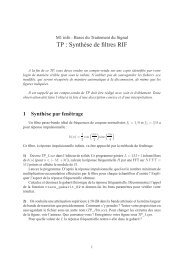Th`ese de Doctorat de l'université Paris VI Pierre et Marie Curie Mlle ...
Th`ese de Doctorat de l'université Paris VI Pierre et Marie Curie Mlle ...
Th`ese de Doctorat de l'université Paris VI Pierre et Marie Curie Mlle ...
Create successful ePaper yourself
Turn your PDF publications into a flip-book with our unique Google optimized e-Paper software.
allows us to allocate the bandwidth left unused by idle and active connections to those<br />
that want to transmit more than their subscribed rate, thus increasing n<strong>et</strong>work revenue.<br />
2.3 Dynamic Bandwidth Provisioning Architectures<br />
Dynamic bandwidth provisioning in Quality of Service n<strong>et</strong>works has recently attracted a<br />
lot of research attention due to its potential to achieve efficient resource utilization while<br />
providing the required quality of service to n<strong>et</strong>work users [1, 2, 3, 4, 5].<br />
In [1], the authors introduce a dynamic provisioning architecture and a s<strong>et</strong> of dynamic<br />
no<strong>de</strong> and core provisioning algorithms for interior no<strong>de</strong>s and core n<strong>et</strong>works, respectively.<br />
The no<strong>de</strong> provisioning algorithm prevents transient violations of service level agree-<br />
ments (SLA) by predicting the ons<strong>et</strong> of service level violations based on a multiclass virtual<br />
queue measurement technique, and by adjusting the service weights of weighted fair queue-<br />
ing schedulers at core routers. Persistent service level violations are reported to the core<br />
provisioning algorithm, which dimensions traffic aggregates at the n<strong>et</strong>work ingress edge.<br />
The core provisioning algorithm is <strong>de</strong>signed to address the problem of provisioning<br />
DiffServ traffic aggregates by taking into account fairness issues across different traffic<br />
aggregates and also within the same aggregate whose pack<strong>et</strong>s take different routes through<br />
a core IP n<strong>et</strong>work. The core provisioning algorithm has two functions: to reduce edge<br />
bandwidth immediately after receiving a Congestion Alarm signal from a no<strong>de</strong> provisioning<br />
module, and to provi<strong>de</strong> periodic bandwidth realignment to establish a modified max-min<br />
bandwidth allocation for traffic aggregates.<br />
In [3], the authors propose a s<strong>et</strong> of dynamic provisioning algorithms that operate at<br />
the edge routers of a differentiated services core n<strong>et</strong>work. These edge mechanisms inclu<strong>de</strong>:<br />
1) ingress dynamic link sharing, which augments class based queueing techniques with<br />
bandwidth utility functions so that dynamic link sharing can be used to distribute band-<br />
width among traffic conditioners located at edge routers; and 2) egress dynamic capacity<br />
29










